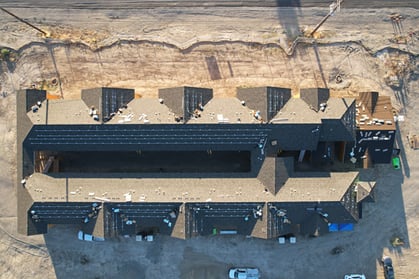The Inflation Reduction Act (IRA) was signed into U.S. federal law on Aug 16, 2022. As its name suggests, it was created to fight inflation by reducing the federal government budget deficit.
However, the act was not only created to curtail inflation. It also included many provisions related to clean energy. In fact, it’s considered by many to be the most significant clean energy legislation ever passed in the U.S.!
Solar is among the clean energy industries impacted. Its solar provisions—in particular, generous tax credits—provide property owners with yet another great motivation to go solar.
In this blog post, we’ll explore:
- How the IRA impacts homeowners
- How commercial property owners are impacted
- How to take advantage of the solar incentives
So, what does the Inflation Reduction Act of 2022 do for solar?
Inflation Reduction Act - Solar Tax Credits for Homeowners
 The IRA’s solar benefits to homeowners are divided into two key pieces: Solar Investment Tax Credits (ITC) and the Home Owner Managing Energy Savings (HOMES) rebate program.
The IRA’s solar benefits to homeowners are divided into two key pieces: Solar Investment Tax Credits (ITC) and the Home Owner Managing Energy Savings (HOMES) rebate program.
Solar Investment Tax Credits (ITC)
The ITC is a tax credit for individuals who install solar energy systems on their residential properties. Previously, it was initially slated to conclude in 2024, but the Inflation Reduction Act extended the solar Investment Tax Credits (ITC) by a substantial 10 years. The IRA not only keeps this benefit alive but also elevates it to 30%, surpassing the previously planned 26% for 2022 and 22% for 2023.
The ITC benefits include not only solar panels but also home batteries (solar energy storage) with at least 3 kWh of storage capacity. For example, Tesla Powerwalls, FranklinWH batteries, and Enphase batteries are eligible.
The new provisions mean even more savings on top of the 30% for some American homeowners. Those who add solar to their residence in an eligible low-income or disadvantaged community may receive 10-20% in additional tax credits.
The ITC has benefitted nearly all of our thousands of solar customers. Often, it saves our customers $6,000 or more off of their tax bill. From when they first reach out to installation day, we work with our solar customers to ensure that they get all of the tax credits they are eligible to receive.
Home Owner Managing Energy Savings (HOMES) Rebate Program
The Inflation Reduction Act also provides $4.3 billion to State Energy Offices under the HOMES program. Through this program, families can save up to $4,000 in tax credits for installing solar.
For program eligibility, the solar energy system must reduce electricity consumption by at least 15%. Systems that reduce consumption by more than 15% are eligible for the most tax credits.
 Inflation Reduction Act - Solar Tax Credits for Commercial Property Owners
Inflation Reduction Act - Solar Tax Credits for Commercial Property Owners
Commercial, industrial, governmental, and non-profit property owners can also benefit from the Inflation Reduction Act’s solar provisions. Similar to homeowners, these individuals enjoy a decade-long extension of the solar Investment Tax Credits.
The exact credit amounts vary according to:
- Solar system size in megawatts (MWac)
- Materials used
- Project location
Below are some project characteristics that may lead to more tax credits:
- Larger solar system size
- Use of domestic materials (10% bonus credit)
- Located in an energy community* (10% bonus credit)
- Located in a low-income community or on Native American land (10-20% bonus credit)
- Solar installed on low-income housing
*Energy communities (also called “brownfield areas”) are communities that have been historically impacted by environmentally harmful industries. You can find a map of these communities here.
Home Owner Managing Energy Savings (HOMES) Rebate Program
Some commercial property owners also stand to benefit from the Home Owner Managing Energy Savings (HOMES) rebate program. Owners of multi-family residences who install solar can save up to $4,000 in tax credits per dwelling unit, up to a maximum of $400,000 per multi-family building.
To qualify for the program, the solar energy system must achieve a minimum 15% reduction in electricity consumption. Systems that surpass this threshold are eligible for the most credits.
Need help? Citadel is trusted by many reputable homebuilders and commercial property owners for solar projects. Reach out to us and we’ll help you determine how much you’re eligible to save.
How to take advantage of Inflation Reduction Act solar tax credits
So, what should you do to secure these substantial tax credits?
If you’ve already gone solar…
If you’re a homeowner and installed solar on or after January 1st, 2022, you can claim the residential solar Investment Tax Credits by submitting Form 5695 when you file your taxes.
 If you own a commercial, industrial, governmental, or non-profit property and installed solar on or after January 1st, 2022, you can claim their ITC by submitting Form 3468 when filing your taxes.
If you own a commercial, industrial, governmental, or non-profit property and installed solar on or after January 1st, 2022, you can claim their ITC by submitting Form 3468 when filing your taxes.
If you haven’t gone solar yet…
If you haven’t yet installed a solar energy system, the next step is to reach out to a trustworthy solar company. That team should not only install your solar energy system but also help you ensure that you take advantage of all solar tax credits at your disposal.
When choosing a solar installer, look for the following:
- Licenses and certifications – Legitimate solar installers have, at minimum, a solar contracting license. But also look for additional certifications and partnerships. Are they (like Citadel) endorsed by solar product manufacturers like SolarEdge, Enphase, FranklinWH, SPAN, Tesla, and REC Group? These selective certifications signal a commitment to high-quality work.
- Longevity – Steer clear of solar businesses established only a few years back as they are less experienced and more likely to go out of business. Instead, seek a company with a wealth of experience. For example, our team at Citadel has decades of solar (and roofing) experience.
- Established homebuilder relationships – Whether you're a homeowner or a business owner, long-standing associations with homebuilders are positive indicators for a solar company. Because California homebuilders are on the hook for 10 years of solar system functionality, they are extremely scrupulous about their solar installation partners. Citadel, for example, is the trusted choice for over 80 of California's largest homebuilders.
- Comprehensive insurance – Always verify that your potential solar partner has full insurance coverage. Read your paperwork carefully. Don’t be afraid to ask questions, and always get important responses in writing. Additionally, check their contractor license number with the Contractors State License Board (CSLB) to ensure that both their license and insurance are in good standing.
- 5-star reviews – Thoroughly research potential solar installers’ reviews online. Don't limit your search to the company's website. Instead, branch out to explore third-party platforms like Google, Yelp, and EnergySage for unbiased perspectives.
In Conclusion
Solar incentives and regulations constantly change on the federal level, as well as on the state level here in California.
If you’re in California, we’ll gladly be your no-pressure guide and help you discover the best solar system design for you, potentially including solar batteries.
We will also help you navigate solar legislation so you can determine the amount of solar tax incentives you are eligible to receive.
California homeowners and commercial property owners: Be sure to request a free quote from our team. We’ll follow up promptly to help you learn about and maximize your solar benefits, including tax incentives.



